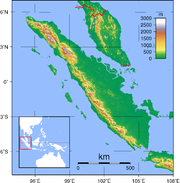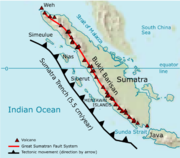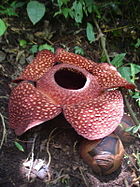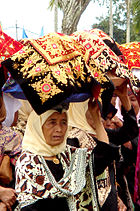
Sumatra
About this schools Wikipedia selection
This selection is made for schools by a children's charity read more. A good way to help other children is by sponsoring a child
Sumatra (also spelled Sumatera) is the sixth largest island in the world (approximately 470,000 km²) and is the largest island entirely in Indonesia (two larger islands, Borneo and New Guinea, are partially in Indonesia).
Etymology
Sumatra was known in ancient times by the Sanskrit names of Swarnadwīpa ("Island of Gold") and Swarnabhūmi ("Land of Gold"), due likely to the gold deposits of island's highlands. Arab geographers referred to the island as Lamri (Lamuri, Lambri or Ramni) in the 10-13th centuries, in reference to a kingdom near modern day Banda Aceh which was the first landfall for traders. Late in the 14th century the name Sumatra became popular, in reference to the kingdom of Samudra which was a rising power. European writers in the 19th century found that the indigenous inhabitants did not have a name for the island.
History
People who spoke Austronesian languages first arrived in Sumatra around 500 BCE, as part of the Austronesian expansion from Taiwan to Southeast Asia. With its location in the India-China sea trade route, several trading towns flourished, especially in the eastern coast, and were influenced by Indian religions. One of the earliest known kingdoms was Kantoli, which flourished in the 5th century AD in southern Sumatra. Kantoli was replaced by the Empire of Srivijaya and then later by the Kingdom of Samudra. Srivijaya was a Buddhist monarchy centered in what is now Palembang. Dominating the region through trade and conquest throughout the 7th to 9th centuries, the Empire helped spread the Malay culture throughout Sumatra, Malay Peninsula, and western Borneo. The empire was a thalassocracy, or maritime power that extended its influence from island to island. Palembang was a centre for scholarly learning, and it was there the Chinese Buddhist pilgrim I Ching studied Sanskrit in 671 CE before departing for India. On his journey to China he spent four years in Palembang translating Buddhist texts and writing two manuscripts.
Srivijayan influence waned in the 11th century after it was defeated by the Chola Empire of southern India. Sumatra was then subject to conquests from Javanese kingdoms, first Singhasari and subsequently Majapahit. At the same time Islam made its way to Sumatra, spreading through contacts with Arabs and Indian traders.
By the late 13th century, the monarch of the Samudra kingdom had converted to Islam. Marco Polo visited the island in 1292 and Ibn Battuta visited twice during 1345-1346. Samudra was succeeded by the powerful Aceh Sultanate, which survived to the 20th century. With the coming of the Dutch, the many Sumatran princely states gradually fell under their control. Aceh, in the north, was the major obstacle, as the Dutch were involved in the long and costly Aceh War (1870-1905).
On December 26 2004, the western coast and islands of Sumatra, particularly Aceh province, were devastated by a nearly 15 meter high tsunami following the 9.2- magnitude Indian Ocean earthquake. The death toll surpassed 170,000 in Indonesia alone, primarily in Aceh.
In 2005 there was an 8.7 magnitude aftershock of the previous earthquake in December 2004. See 2005 Sumatran Earthquake. In addition to the subduction megathrust earthquake off the west coast, Sunda arc, the Great Sumatran Fault, a transform fault, runs the entire length of the island. The pressure on this fault increased dramatically after the December 2004 earthquake, and seismologists are afraid an earthquake is going to occur soon. The fault ends directly below the devastated city of Banda Aceh.
Administration
The administrative regions of Sumatra (or the smaller islands nearby) are:
- Aceh - capital: Banda Aceh
- Bangka-Belitung - capital: Pangkalpinang
- Bengkulu - capital: Bengkulu
- Jambi - capital: Jambi
- Lampung - capital: Bandar Lampung
- Riau - capital: Pekanbaru
- Riau Islands - capital: Tanjung Pinang
- West Sumatra (Sumatera Barat) - capital: Padang
- South Sumatra (Sumatera Selatan) - capital: Palembang
- North Sumatra (Sumatera Utara) - capital: Medan
Geography
The longest axis of the island runs approximately 1,790 km (1,100 miles) northwest - southeast, crossing the equator near the centre. At its widest point the island spans 435 km (270 miles). The interior of the island is dominated by two geographical regions: the Barisan Mountains in the west and swampy plains in the east.
To the southeast is Java, separated by the Sunda Strait. To the north is the Malay Peninsula, separated by the Straits of Malacca. To the east is Borneo, across the Karimata Strait. West of the island is the Indian Ocean.
The backbone of the island is the Barisan mountains chain, with the active volcano Mount Kerinci's 3,805 m (12,467 ft) the highest point, located at about the midpoint of the range. The volcanic activity of this region endowed the region with fertile land and beautiful sceneries, for instance around the Lake Toba. It also contains deposits of coal and gold.
To the east, big rivers carry silt from the mountain, forming the vast lowland interspersed by swamps. Even if mostly unsuitable for farming, the area is currently of great economic importance for Indonesia. It produces oil from both above and below the soil— palm oil and petroleum.
Most of Sumatra used to be covered by tropical rainforest, but economic development coupled with corruption and illegal logging has severely threatened its existence. Conservation areas have not been spared from destruction, either.
The island is the world's 5th highest island, although only the third highest in the Indonesian archipelago.
Flora and fauna
Sumatra supports a wide range of vegetation types which are home to a rich variety of species, including 17 endemic genera of plants. Unique species include: Sumatran Pine, Rafflesia arnoldii (world's largest individual flower), Titan arum (world's tallest and largest inflorescence flower).
The island is home to 201 mammal species and 580 bird species. There are 9 endemic mammal species on mainland Sumatra and 14 more endemic to the nearby Mentawai Islands. The species present include: Sumatran Tiger, Sumatran Orangutan, Sumatran Rhinoceros, Sumatran Elephant, Sumatran Striped Rabbit, Dhole, Dayak Fruit Bat, Malayan Tapir, Malayan Sun Bear and the Bornean Clouded Leopard.
The major threats to Sumatran forest are the pulp and paper industry and expansion of palm oil plantations.
The island includes more than 10 National Parks, including 3 which are listed as the Tropical Rainforest Heritage of Sumatra World Heritage Site— Gunung Leuser National Park, Kerinci Seblat National Park and Bukit Barisan Selatan National Park.
Demographics
Sumatra is not very densely populated, about 96 people per km²—more than 45 million people in total. It is nonetheless the fourth most populous island in the world. The most populous regions include most of North Sumatra and central highlands in West Sumatra, while the major urban centers are Medan and Palembang.
The people composed of many different ethnic groups, speaking 52 different languages. Most of these groups, however, share many similar traditions and the different tongues are closely related. Malay-speaking people dominate the eastern coast, while people in the southern and central interior speak languages related to Malay, such as the Lampung and Minangkabau people. The highland of northern Sumatra is inhabited by the Bataks, while the northernmost coast is dominated by Acehs. Ethnic Chinese minorities are also present in urban centers.
A majority of people in Sumatra are Muslims (87%), while 10% are Christians, 2% are Buddhist and 1% Hindu. Most central Bataks are Protestant Christians—a religion introduced by Ludwig Ingwer Nommensen, a German.





